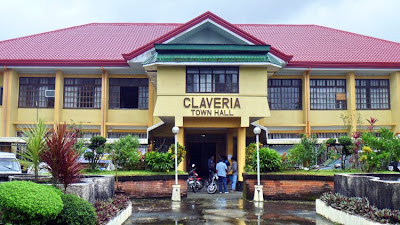| Kapurpurawan Rock Formation: The Sphinx-like “Head” |
After our biscocho and salt making observation tour in Pasuquin, our Lakbay Norte 2 media group then boarded our bus and proceeded to the fellow Ilocos Norte town of Burgos. From the National Rd. our bus turned towards a gravel road and traversed it for about 3 kms. until we reached a makeshift picnic hut, our jump-off point for the amazing, unique and Sphinx-like Kapurpurawan Rock Formation, one of the best places to visit in the town, aside from the iconic Cape Bojeador Lighthouse, the country’s tallest.
| Bonsai-like plants amid pools of limpid sea water |
From the hut, it was a 30-min. walk, along concrete steps, dirt track and then, through a tidal pool. At the tidal pool, sea water-filled coral rock pools, of varying sizes, and bonsai-like vegetation can be seen sporadically. The rock formation was formed from sandstone naturally carved by weathering from wind, sand and water to create different surreal shapes such as the iconic “Head,” “Cradle” and the “Resting Dragon.” The word kapurpurawan was derived from the Ilocano root word puraw meaning “white” and these formations are said to be much whiter during the summer months of April and May.
| This rock formation, possibly the “Resting Dragon,” looks like a slithering cobra about to pounce |
Our short Kapurpurawan Rock Formation hike made us hungry and, as it was lunchtime, we proceeded to the nearby, picturesque town of Paoay for lunch at Cafe Herencia.
Check out “Restaurant Review: Cafe Herencia“
Herencia Cafe: MacArthur St., Brgy. 14, Sangladan, Paoay, Ilocos Norte. Tel: (077) 614-0214





